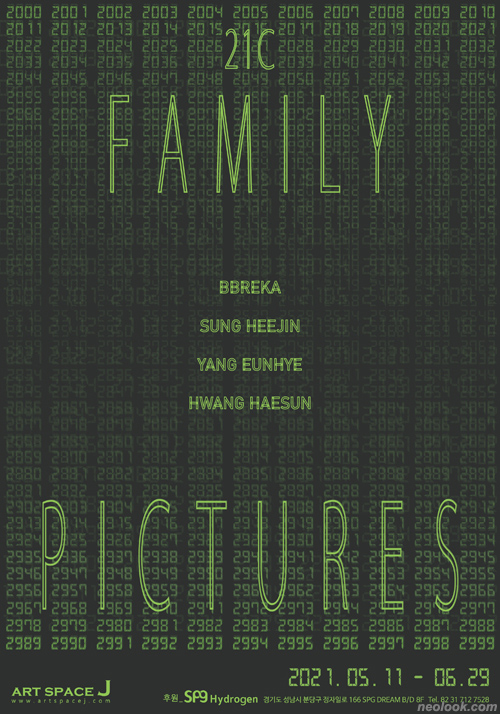- ● homepage
- ● archives
- ● restoration
- ● books
- ● big banners
- ● post board
- ■ neo's search
- ■ about us
- ■ 게재방법 안내
- 개인정보처리방침

- [email protected]
- Tel. 02_335_7922
- Fax. 02_335_7929
- 10:00am~04:30pm
- 월요일~금요일
- 3/3(월) 대체공휴일

21c_Family Pictures
BBREKA(쁘레카)_성희진_양은혜_황혜선展 2021_0511 ▶ 2021_0629 / 일,공휴일 휴관
별도의 초대일시가 없습니다.
관람시간 / 10:00am~06:00pm / 토요일_11:00am~06:00pm / 일,공휴일 휴관
아트스페이스 J ART SPACE J 경기도 성남시 분당구 정자일로 166 SPG Dream 빌딩 8층 Tel. +82.(0)31.712.7528 www.artspacej.com
'가족(家族)'. 주로 부부를 중심으로 한, 친족 관계에 있는 사람들의 집단, 또는 그 구성원. 혼인, 혈연, 입양 등으로 이루어진다. 이는 가족의 사전적 정의로 일반적으로 한 집에서 함께 살면서 끼니를 같이하는 사람인 식구와 유의어로 사용된다. 오늘날 우리나라 총 가구수는 2,309만 3,108가구이며 평균 가구원수는 2.4명으로, 이 중 1인 가구수는 39.2%를 차지한다. 1) 한편 반려 동물을 키우는 가구는 점점 늘어 604만 가구로 우리 국민은 4명 중 1명 비율로 반려동물과 함께 살고 있는 셈이다. 2) 이처럼 전통적인 가족의 개념은 사회, 경제적 구조의 변화에 따른 개인의 취향과 기호, 그리고 가치관에 따라 다양한 양상으로 변모해 왔으며, 그 의미와 관계에 대한 질문들 역시 예술계의 주된 화두가 되어오고 있다. 이에 아트스페이스 J에서는 가정의 달을 맞아 급격한 사회 변화에 따른 동시대 한국 가족의 모습을 살펴보고자, 사진, 회화, 그리고 설치작업으로 이루어진 『21c_Family Pictures』展을 기획하게 되었다.
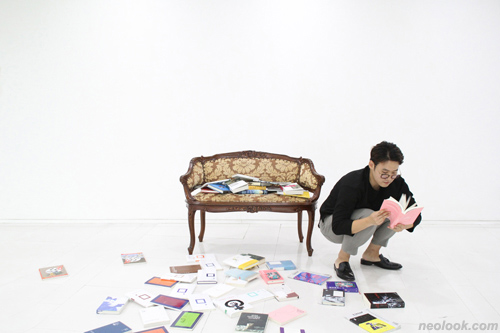
- 쁘레카_1인 가구 프로젝트_2017

- 쁘레카_1인 가구 프로젝트_2017
신재연과 최진연, 두 작가로 구성된 아트팀인 BBREKA(쁘레카) 3) 는 2015년부터 '1인 가구 사진관 프로젝트'를 진행해 오고 있다. 이 프로젝트는 '가구'라는 집합체를 면으로, '1인 개인'을 점으로 환원하여, 하나의 점인 1인, 즉 개인 가구들이 인간이 아니더라도 다른 대상을 가족 구성원으로 선택하여 대안적 면을 이루며 살 수도 있다는 가정하에 시작되었다. 이들은 스튜디오에 전통적인 4인 가구 기준의 가족 사진관 촬영 소파를 설치하고 1인 가구 참여자들이 자신의 반려 동물이나 식물, 혹은 사물들과 함께하는 가족 사진을 촬영하여, 다양한 형태의 피사체들과 애정 어린 관계를 맺으며 살아가는 오늘날 가족의 모습을 사진이라는 매개체로 기록해 오고 있다.

- 양은혜_여름여자_캔버스에 아크릴채색_72.7×72.7cm_2016
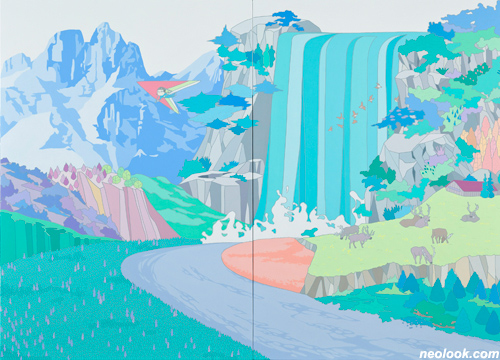
- 양은혜_hangout_캔버스에 아크릴채색_160.6×324.4cm_2015
1인 가구의 보편화는 삶을 대하는 동시대인들의 인식도 변화시켰다. 'You only live once.' '당신의 삶은 한 번뿐! 오직 한 번뿐인 자신의 삶을 즐겨라.' 양은혜 작가는 '지금', '여기'를 최고의 가치로 여기며 사회의 보편적 잣대나 타인의 시선을 의식하지 않고 나만의 기준으로 살아가는 젊은 욜로(YOLO)족 세대의 삶의 방식을 담담하게 캔버스에 담아내고 있다. 그녀는 현재의 풍요롭고 자유로운 삶을 위해 불안정한 미래를 담보로 하는 우리네 젊은이들의 '웃픈 자화상'을 통해 우리 사회의 변화하는 가치관과 시대의 정체성을 가감 없이 드러내고 있다.
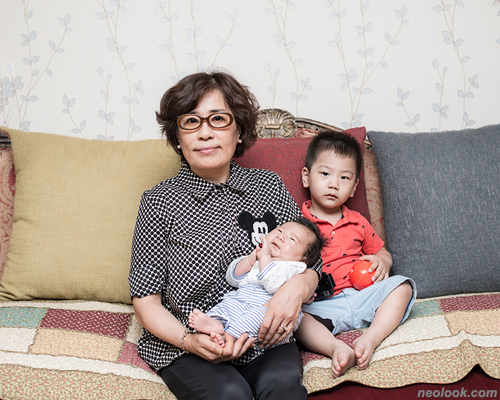
- 성희진_grand·mother_#1_종이에 프린트_91.6×114.3cm_2015

- 성희진_BUSYKID_Ribbon Gymnastics_잉크젯 프린트_56×76cm_2013
그런가 하면, 사진가 성희진은 급격한 산업화와 고도의 경제 성장을 이룩한 한국이라는 사회에서 자라고 있는 21세기의 아이들과 이들을 위해 할머니와 엄마의 역할을 동시에 수행하는 이 시대 '할마'들의 모습을 「Busykid」와 「Grand-Mother」에서 보여주고 있다. 그 어느 때보다 물질적으로 풍요로운 지원을 받고 있는 오늘날 아이들이지만, 이를 위해서는 맞벌이로 인한 부모의 부재가 수반되며, 이는 자연스럽게 손주들을 위해 기꺼이 육아를 책임지는 할머니들의 황혼 육아로 이어진다. 그녀의 작품 속에는 '우리보다 더 나은 삶을 살게 하기 위해'라는 명목하에 오늘도 묵묵히 하루를 살아가는 원더 할마들에 대한 작가의 따뜻한 시선과 세대를 초월하는 공동체의 보편적인 가치가 담겨있다.
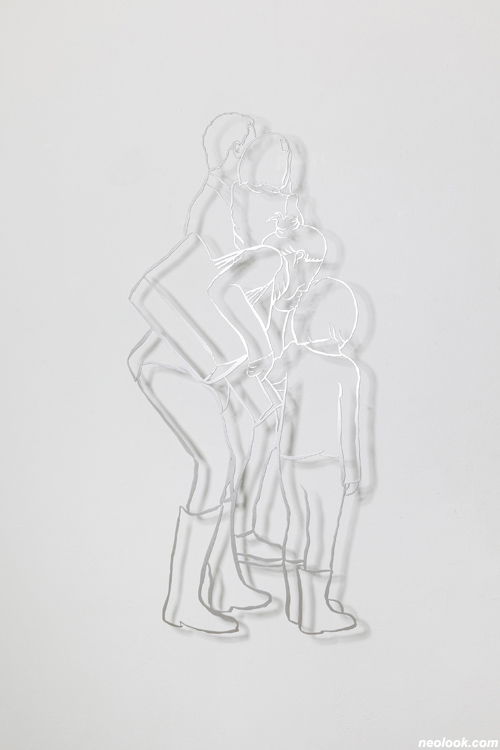
- 황혜선_가족_알루미늄 분체도장_57×120×0.3cm_2020

- 황혜선_손녀와 할머니_알루미늄 분체도장_78×120×0.3cm_2020
아이의 옷 매무새를 만져주는 어머니, 나란히 발을 맞추어 걸어가는 부자의 모습, 다정하게 손을 잡고 걸어가는 손녀와 할머니, 옹기종기 모여있는 세자매 가족의 뒷모습. 보기만해도 마음이 따뜻해지는 우리네 일상 속 가족의 평범한 모습들은 황혜선 작가의 '드로잉-조각'들이다. 그녀의 조각들은 평범하기 그지없는 일상의 순간들이지만 작가가 이를 특유의 섬세한 관찰과 사유로 겹겹이 기록함으로써 동시대 가족들의 일상성과 시간성을 오히려 새로운 시각으로 바라보게 만든다. ● 얼마 전 자발적 비혼모인 한 방송인의 공중파 예능 프로그램 출연 소식에 대해 비혼 출산을 장려할 수 있다는 반대의 목소리가 국민청원으로까지 이어지며 '정상가족'에 대한 논란이 일어났다. '특별한 변동이나 탈이 없이 제대로인 상태'를 의미하는 '정상'의 범위를 우리는 어떻게, 어디까지 규정할 수 있을까? 앞서 동시대 작가들의 작업을 통해 살펴봤듯이, 이제는 '가족이 무엇인가'를 규명하기보다는 '무엇을 가족으로 볼 수 있을 것인가'로 우리의 인식도 변화하고 있다. '세상에 변하지 않는 것은 변하지 않는다는 사실 밖에 없다'는 누군가의 말처럼 한 사회의 근간을 이루는 가족의 패러다임은 시대의 흐름에 따라 변화해 왔고, 지금도 변모해가고 있으며, 앞으로도 끊임없이 변화를 거듭해 갈 것이다. 그렇다면 21세기를 살아가는 우리의 미래에는 어떠한 새로운 가족지형도가 그려질지 한 번쯤 생각해 보는 것도 흥미로운 일이 될 것이다. ■ 한혜원
* 각주 1) 2020년 12월 행정안전부 주민등록 인구 통계 기준 2) KB금융지주 경영연구소 '2021 한국반려동물보고서' 3) BBREKA(쁘레카)는 공사현장에서 사용되는 공구 breaker의 변형된 외래어로, 벽을 허물고 바닥을 뚫듯, 마주하는 사회적 문제들을 파헤쳐나가고 돌파하자는 뜻을 담고 있다. BBREKA (Preca) is a modified foreign word for the tool breaker used at the construction site, meaning to break through and dig through social problems encountered as if breaking down walls and penetrating floors.
FAMILY. It is a group of people or members of a kinship, mainly based on a couple. It usually consists of a married couple and their children, offsprings and/or by adoption. This is the dictionary definition of a family, and the term is commonly used in place of a household consisting of people who live and eat together under the same roof. Today, the total number of households in Korea is around 23 million and the average number of households is 2.4, of which one-person-household accounts for 39.2%. Meanwhile, the number of households raising pets has increased to 6.04 million, which means that one out of every four Koreans lives with a non-human, often furry, friend. The concept of family nowadays is surely more flexible, which depends on individual tastes, preferences, and values in response to changes in social and economic structure, and questions about its meaning and relationship have also become a major topic in the art world. Accordingly, Art Space J organized 『21c_Family Pictures』, which consists of photography, painting, and installations to examine the contemporary Korean family in the wake of rapid social changes. ● BBREKA, an art team composed of two artists, Shin Jae-yeon and Choi Jin-yeon, has been working on the "One-Person Family Photo Studio Project" since 2015. The project began on the assumption that an individual can choose to include a non-human companion to form a household. They set up a traditional family photo studio for a four-person household and photographed single-person families with their pets, plants, or objects, photographing people in loving relationships with various types of companions. ● The societal acknowledgement of single-person households has also changed the perception of life in our society. 'You only live once. 'Enjoy your one-and-only life.' Yang Eun-Hye captures the lifestyle of the YOLO generation who values "now" and "here" as the highest priorities and lives by their own standards without minding the "norm" of the society or other people's eyes. She reveals the changing values of our society and the identity of the times through the "funny and sad self-portrait" of our young people whose unstable prospects for the future is the collateral for the freedom and the pleasures that they enjoy. ● Photographer Sung Hee-Jin shows in Busykid and Grand-Mother the children of the 21st century growing up in the Korean society, which undoubtedly has achieved rapid industrialization and high economic growth. Their grandmothers are appropriately nicknamed Halma (Hal refers to grandmother and Ma refers to mother in Korean), in that they play the roles of both a grandmother and a mother for their grand-children. Today's children are nourished and supported better than ever, but this often means the absence of parents, due to the double-income structure of the households, which naturally leads to the grandmothers stepping in to take care of their grandchildren. Sung's work contains the value of multi-generational family as it reveals the artist's warm gaze on Wonder Halma, whose capable and loving hands fulfill daily responsibilities "to help them live a better life than us." ● A mother's loving touch of a child's clothing, a father and his son walking side by side, a grand-daughter and grand-mother holding hands affectionately, and a family with three sisters gathered together. Theses ordinary images of our family which warms our hearts are "Drawing-Pieces" by Hwang Hye-Sun. Her sculptures may be of ordinary moments but allow the viewers to think of our routine life in a new way by recording them in layers based on the artist's unique and delicate observations and reasons for these scenes ● Not long ago, a controversy over what is a "normal family" arose and even led to a national petition, when an unmarried broadcaster spoke of and encouraged non-marriage childbirths in an over-the-air entertainment program. How and how far can we go beyond the scope of 'normal' - a condition without any special changes or harm? As you will see in the works of the above-mentioned contemporary artists, our perception is now changing from "what is a family" to" what can we see as a family." As the saying goes, "The only thing that doesn't change is the change itself." The paradigm of a family that forms the basis of a society is evolving continuously. Then it would be interesting to think about what kind of new family topography will surface as the 21st century unfolds. ■ Han, Hye-won
Vol.20210511a | 21c_Family Pictures展

